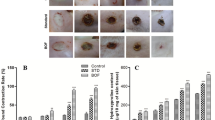Abstract
A full-thickness burn wound model was used to evaluate the effects of a topically applied gel-based nitric oxide donor on wound healing in rats. The histological study demonstrated that the nitric oxide (NO) application significantly promoted re-epithelization that resulted in a fast recovery of burn wound. The histological sections further revealed that inflammatory cell infiltration in the NO-treated group was significantly increased in comparison to the control group. The enhanced accumulation of inflammatory cells resulted in a higher expression of myeloperoxidase (MPO) that was detected with imunoblotting. An immunohistochemistry study with CD31, a specific marker for endothelial cells, indicated that NO treatment markedly stimulated angiogenesis. Evaluation of collagen synthesis by immunohistochemistry with procollagen antibody demonstrated a significantly increased collagen synthesis in NO-treated wound bed. We concluded that NO treatment promoted re-epithelialization and wound closure by means of enhanced inflammatory cell infiltration, and that it promoted angiogenesis and facilitated collagen synthesis in the wound bed.




Similar content being viewed by others
References
Werner S, Grose R. Regulation of wound healing by growth factors and cytokines. Physiol Rev 2003;83:835–870
Yamaguchi Y, Yoshikawa K. Cutaneous wound healing: an update. J Dermatol 2001;28:521–534
Schwentker A, Vodovotz Y, Weller R, et al. Nitric oxide and wound repair: role of cytokines? Nitric Oxide 2002;7:1–10
Childress BB, Stechmiller JK. Role of nitric oxide in wound healing. Biol Res Nurs 2002;4:5–15
Lee PC, Salyapongse AN, Bragdon GA, et al. Impaired wound healing and angiogenesis in eNOS-deficient mice. Am J Physiol 1999;277(4 Pt 2):H1600–H1608
Yamasaki K, Edington HD, McClosky C, et al. Reversal of impaired wound repair in iNOS-deficient mice by topical adenoviral-mediated iNOS gene transfer. J Clin Invest 1998;101:967–971
Shearer JD, Richards JR, Mills CD, et al. Differential regulation of macrophage arginine metabolism: a proposed role in wound healing. Am J Physiol 1997;272(2 Pt 1):E181–E190
Witte MB, Kiyama T, Barbul A. Nitric oxide enhances experimental wound healing in diabetes. Br J Surg 2002;89:1594–1601
Shi HP, Most D, Efron DT, et al. Supplemental L-arginine enhances wound healing in diabetic rats. Wound Repair Regen 2003;11:198–203
Witte MB, Thornton FJ, Tantry U, et al. L-Arginine supplementation enhances diabetic wound healing: involvement of the nitric oxide synthase and arginase pathways. Metabolism 2002;51:1269–1273
Shi HP, Efron DT, Most D, et al. Supplemental dietary arginine enhances wound healing in normal but not inducible nitric oxide synthase knockout mice. Surgery 2000;128:374–378
Ekstrand AJ, Cao R, Bjorndahl M, et al. Deletion of neuropeptide Y (NPY) 2 receptor in mice results in blockage of NPY-induced angiogenesis and delayed wound healing. Proc Natl Acad Sci USA 2003;100:6033–6038
Krischel V, Bruch-Gerharz D, Suschek C, et al. Biphasic effect of exogenous nitric oxide on proliferation and differentiation in skin derived keratinocytes but not fibroblasts. J Invest Dermatol 1998;111:286–291
Klein SA, Bond SJ, Gupta SC, et al. Angiogenesis inhibitor TNP-470 inhibits murine cutaneous wound healing. J Surg Res 1999;82:268–274
Galeano M, Deodato B, Altavilla D, et al. Adeno-associated viral vector-mediated human vascular endothelial growth factor gene transfer stimulates angiogenesis and wound healing in the genetically diabetic mouse. Diabetologia 2003;46:546–555
Colwell AS, Beanes SR, Soo C, et al. Increased angiogenesis and expression of vascular endothelial growth factor during scarless repair. Plast Reconstr Surg 2005;115:204–212
Detmar M, Yeo KT, Nagy JA, et al. Keratinocyte-derived vascular permeability factor (vascular endothelial growth factor) is a potent mitogen for dermal microvascular endothelial cells. J Invest Dermatol 1995;105:44–50
Brown LF, Yeo KT, Berse B, et al. Expression of vascular permeability factor (vascular endothelial growth factor) by epidermal keratinocytes during wound healing. J Exp Med 1992;176:1375–1379
Ziche M, Morbidelli L, Choudhuri R, et al. Nitric oxide synthase lies downstream from vascular endothelial growth factor-induced but not basic fibroblast growth factor-induced angiogenesis. J Clin Invest 1997;99:2625–2634
Morbidelli L, Chang CH, Douglas JG, et al. Nitric oxide mediates mitogenic effect of VEGF on coronary venular endothelium. Am J Physiol 1996;270(1 Pt 2):H411–H415
Vernet D, Ferrini MG, Valente EG, et al. Effect of nitric oxide on the differentiation of fibroblasts into myofibroblasts in the Peyronie’s fibrotic plaque and in its rat model. Nitric Oxide 2002;7:262–276
Chu AJ, Prasad JK. Up-regulation by human recombinant transforming growth factor beta-1 of collagen production in cultured dermal fibroblasts is mediated by the inhibition of nitric oxide signaling. J Am Coll Surg 1999;188:271–280
Witte MB, Thornton FJ, Efron DT, et al. Enhancement of fibroblast collagen synthesis by nitric oxide. Nitric Oxide 2000;4:572–582
Thornton FJ, Schaffer MR, Witte MB, et al. Enhanced collagen accumulation following direct transfection of the inducible nitric oxide synthase gene in cutaneous wounds. Biochem Biophys Res Commun 1998;246:654–659
Muscara MN, McKnight W, Asfaha S, et al. Wound collagen deposition in rats: effects of an NO-NSAID and a selective COX-2 inhibitor. Br J Pharmacol 2000;129:681–686
Acknowledgments
This work was supported by the National Institutes of Health (NL64221, GM061731, P30DK56338); the John S. Dunn, Harold and Leihla Mathers, and Robert A. Welch foundations; The Army Defense Department; and The University of Texas.
Author information
Authors and Affiliations
Corresponding author
Additional information
This work was presented at the Molecular Surgeon Symposium on Vascular Injury, Repair and Remodeling at the Baylor College of Medicine, Houston, Texas, May 15 and 16, 2006. The symposium was supported by a grant from the National Institutes of Health National Institute of Health (to C. Chen: R13 HL0836500).
Rights and permissions
About this article
Cite this article
Zhu, H., Ka, B. & Murad, F. Nitric Oxide Accelerates the Recovery from Burn Wounds. World J. Surg. 31, 624–631 (2007). https://doi.org/10.1007/s00268-007-0727-3
Published:
Issue Date:
DOI: https://doi.org/10.1007/s00268-007-0727-3




